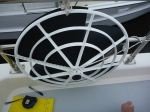We had paravanes on our 43' Defever that had winches for lowering the outreaching "booms". They were heavy, took time to operate, difficult to retrieve, BUT Worth every bit of the trouble!!! We took the boat over 15,000nm, and even though we are fair weather boaters, we got caught several times in what we considered "rough seas"! The paravanes made the voyage "bearable", although when it really gets rough, the fraction of roll that is not removed can be endured! The biggest mistake is going out in the open and NOT putting the fish in the water! The rough water seems to "sneak up on you"! This, we never seemed to learn! The "fish", reduced our average cruising speed about 1 knot, well worth the improved cruising characteristics! Some boats have the fish also, deployed on winches, which would be a great feature! We seldom had fish come out of the water, and then it was only straight up a foot, or two. We did not feel there was a danger from "flying fish", on our boat! The paravanes definitely do continue to perform even at anchor, particularly in some of the Pacific coast "rolly anchorages, from the Panama Canal northbound. An important feature when you're trying to play "Mexican Train" dominoes! We have not owned a boat with Naids, or a steadying sail, but would certainly not criticize either, and would welcome them as an improvement, I'm sure! You'll appreciate any improvement, after many hours in a long passage, in heavy seas! Dick & Mary Jo

